ISSN 2348-313X (Print)
International Journal of Life Sciences Research ISSN 2348-3148 (online)
Vol. 10, Issue 2, pp: (21-32), Month: April - June 2022, Available at: www.researchpublish.com

ISSN 2348-313X (Print)
International Journal of Life Sciences Research ISSN 2348-3148 (online)
Vol. 10, Issue 2, pp: (21-32), Month: April - June 2022, Available at: www.researchpublish.com
Limnology Research Laboratory, Department of Zoology
Aligarh Muslim University, Aligarh- 202002. Uttar Pradesh, India
DOI: https://doi.org/10.5281/zenodo.6586195
Published Date: 27-May-2022
Abstract: The present investigation on Diggi Pond, located at a distance of about 2 km south-east of the university campus (Lat.270-54 N long.78-04´ E), was conducted during May, 2007-April, 2008 for studying the biodiversity of periphytic community along with various physico-chemical parameters. During the entire study, periphytic community showed a seasonal distribution. Maximum density of periphyton was found in winter (2253 No. /cm2) on natural substrata and in post-monsoon (1191 No. /cm2) on artificial substrata, whereas minimum periphyton density was observed during post winter (479 No. /cm2) on natural substrata and during post winter (842 No. /cm2) on artificial substrata.
Periphytic community on natural substrata was found to be more diversified than that of artificial substrata. During the entire period of the study, five groups of plantperiphyton, namely Bacillariophyceae (18 species), Chlorophyceae (24 species), Myxophyceae (10 species), Euglenophyceae (2 species) and Xanthophyceae (3 species), and four groups of zooperiphyton i.e. Protozoa (2 species) Rotifera (15 species), Cladocera (4 species) and Copepoda (4 species) were found to be present on natural substrata. On artificial substrata, three groups of plantperiphyton i.e. Bacillariophyceae (17 species) Chlorophyceae (13 species), Myxophyceae (7 species) and two groups of zooperiphyton i.e. Protozoa (2 species) and Rotifera (5 species) were found to be present on all the three types of artificial substrata i.e. wooden block, stone and glass substrata. During the entire study, among total periphyton density, bacillariophyceae was the only group which was found as dominant group through out the year.
Keywords: Periphyton, biodiversity, plantperiphyton and zooperiphyton.
Periphyton are the microscopic organisms growing on stones, sticks, aquatic macrophytes and other submerged surfaces, and are useful in assessing the effect of pollutants on lakes, streams and estuaries (APHA,1998). According to Wetzel (1983), the term periphyton is usually referred to describe the micro floral growth on the submerged objects Cole (1983) used the term periphyton to describe micro flora attached to submerged objects along with other living forms like bacteria, fungi and animals like vorticella and the branched carchesium (protozoan). Periphytic communities are sensitive to environmental conditions (Besch et al., 1972) and mainly composed of heterogeneous and diverse assemblage of algal forms forming an important food niche in an aquatic ecosystem. Periphyton being a community in itself has its own cycle of abundance having role to play in the trophic structure and function even though some of the members are common to plankton, bottom biota and periphyton (Singh et al., 2003). Because of its almost universal presence in water and the conspicuous quantity often produced, periphyton play an important role in limnological process of a lake or stream
ISSN 2348-313X (Print)
International Journal of Life Sciences Research ISSN 2348-3148 (online) Vol. 10, Issue 2, pp: (21-32), Month: April - June 2022, Available at: www.researchpublish.com
(Welch, 1952). A wide range of fish mainly hill stream fish and benthic invertebrates including snails, chironomids, mayflies, oligochaetes and several groups of crustaceans subsit on periphyton and form their main diet (Jones et al., 1997). Some information on periphyton from Indian waters include works of Mishra and Singh (1968) Krishna Rao (1990), Sukumaran and Karthikeyan (1999), Singh et al. (2003), Jha (1979) and Laal et al.(1982). Besides entrapping organic detritus, periphyton removes nutrients from the water column and helps to control the dissolved oxygen concentration and pH of the surrounding water (Azim et al., 2002; Dodds, 2003; Bender et al., 2004; Rashid and Pandit, 2005; Cattaneo et al., 2012; Kumar et al., 2013; Nelson et al., 2013). Periphyton successional stage is used as a bioindicator of stream health (Jyrkänkallio-Mikkola et al. 2018; Piggott et al. 2015; Pillsbury et al. 2019; Welsh & Ollivier, 1998).
In the present investigations, detailed study of biodiversity of periphytic community in a fresh water body of Aligarh was undertaken to study the species composition, seasonal variations and seasonal succession of such community in relation to physico-chemical parameters during the period between May, 2007-April, 2008. Besides entrapping organic detritus, periphyton removes nutrients from the water column and helps to control the dissolved oxygen concentration and pH of the surrounding water (Azim et al., 2002; Dodds, 2003; Bender et al., 2004; Rashid and Pandit, 2005; Cattaneo et al., 2012; Kumar et al., 2013; Nelson et al., 2013).
The studied Diggi pond is a perennial fresh water sewage fed pond located at a distance of about 2 km south-east of the university campus. (Lat270-54 ` N long 78-04´ E). It is a shallow eutrophic waterbody and the usual source of its replenishment is sewage water which is fed through small nullahas present on the four corners of the pond and through surface run-off from the surrounding areas during rainy season. It has a more or less flat basin covering an area of 0.8 hectares. The pond is used as a drainage basin into which drainage water sweeps from the surrounding localities. The water of the pond is turbid with luxuriant growth of microscopic algae sometimes forming blooms on the water surface.
Samples were collected from the pond fortnightly between 9-10 a.m. from May, 2007 to April, 2008 to workout parameters like air temperature, water temperature, pH, D.O., CO2, alkalinityand periphyton.
Physico-chemical characteristics of the water body were analyzed after following the works of Theroux et al. (1943), Trivedy & Goel (1984) and APHA (1998). In order to analyze the periphytic flora and fauna of the pond, samples were collected from the natural substrates by scrapping submerged stones, sticks and parts of macrophytes. Artificial substrates of different objects like wood block, stone and glass slide were also suspended in the pond water at a depth of about 50 cm with the help of nylon thread and two iron rods. These artificial substrates include glass slides (7.5x2.5 cm), wooden blocks (7.5x2.5cm) and stones (7.5x2.5 cm). Each substratum was suspended in triplicate so that the average values of periphytic communities attached to particular substratum may give almost a correct quantity and the average of this has been expressed in terms of No. /cm2. The average of the values of periphytic communities in months was taken in each season.
After the completion of incubation period each substratum was taken out and with the help of scalpel and brushes the organisms were detached from the substratum and transferred into plastic viols. All these were fixed in formaldehyde solution and then analyzed under the inverted microscope. Wherever it was possible to identify the organisms up to species level, it was done, otherwise it was taken as single species (sp.) or several species (spp.)
Calculation: for the densities of periphytic organisms per unit area of the surface water was made using the following formula:
Periphyton/cm2=Ax V/v x 1/S; where
A=average no. of organisms per ml, V=volume of scrapings (ml), v = volume of one drop (ml), and S=area of scrapping (in cm2)
ISSN 2348-313X (Print)
International Journal of Life Sciences Research ISSN 2348-3148 (online) Vol. 10, Issue 2, pp: (21-32), Month: April - June 2022, Available at: www.researchpublish.com
The physico-chemical and biological parameters showed a wide range of seasonal fluctuations. The fluctuations in most of the parameters led to the fluctuation in the periphyton density in space and time. Variation in the physico -chemical parameters also affected the density of periphyton on different substrates with different intensity. High values of Dissolved Oxygen (4.7-15.7 mg/L), pH (8.3-9.1), Carbonates (153-250mg/L), Bicarbonates (240-387mg/L) and Hardness (95-195 mg/L (Table-1) of the pond were found to be associated with the higher density of periphyton.
Statistical analysis was also carried out to find out the periphyton relationship with temperature, transparency and dissolved oxygen. Periphyton both on natural and artificial substrata showed significant positive correlation with water temperature. Transparency was negatively correlated with periphyton both on natural and artificial substrata.
Dissolved oxygen showed positive correlation with periphyton on natural substrata whereas negative correlation with periphyton on artificial substrata. This may be due to impact of several environmental factors interacting & influencing collectively both quality & quantity of periphyton. Many other environmental factors such as disturbance, resources, environmental conditions and grazing pressure collectively interact and influence both distribution and species composition of periphyton. Due to this complex regulation, the relative importance and contribution that each factor may exert in shaping the periphytic community is difficult to evaluate and quantify. (Lowe, 1996)
The complexity between water chemistry and periphytic algae makes it difficult to draw explicit conclusions on the relationship. However the result presented here indicates that within the investigated nutrient range eutrophication has a great effect on the temporal and spatial distribution of periphyton.
Seasonal distribution of periphyton showed a peak in winter (2253 No. /cm2, Table-2) on natural substrates and in post monsoon (1191 No. /cm2 , Table- 3) on artificial substrates. The minimum periphyton density was observed during post winter (479 No. /cm2, table-2) on natural substrates and on artificial substrates it was observed during post winter (842 No. /cm2 , Table-3). Several studies have, however, reported periphytic assemblages throughout winter (Meulemans, 1988; Burkholder& Wetzel, 1989; Gustina & Hoffmann, 2000) but few have explored dynamics and relative changes in these winter communities (Carpenter & Kitchell, 1987).
Natural substrates showed more periphyton diversity than that of artificial substrates. During the entire period of study, five groups of algae namely Bacillariophyceae, Chlorophyceae, Myxophyceae, Euglenophyceae and Xanthophyceae and four groups of zooperiphyton i.e Protozoa, Rotifer, Cladocera, and Copepod were found to be present on natural substrates. On artificial substrates three groups of algae i.e.Bacillariophyceae, Chlorophyceae, Myxophyceae and two groups of zooperiphyton i.e. Protozoa and Rotifer were found to be present on all the three types of artificial substrates i.e. wooden block, stone substrate and glass substrate. The maximum no. of periphyton were found to dominate on the surface of stones and wooden blocks as compared to the glass substratum.
Among all the groups of plantperiphyton, observed on both natural and artificial substrates, dominant group was Bacillariophyceae. In winter, post winter and post monsoon, periphyton is often dominated by diatoms, whereas a greater abundance of green algae and cyanobacteria is typically found in post monsoon month. Bacillariophyceae, on natural substrates, contributed about 27.85%-71.91% (Fig.1) and, on artificial substrates, its contribution was about 28.18%63.38%.(Fig.4,5,and 6) In accordance to the seasonal patterns of phytoplankton most studies reported dominance of diatoms in winter, spring and autumn and a greater abundance of periphytic green algae and cyanobacteria during summer. (Gons, 1982; Cattaneo, 1987; Burkholder& Wetzel, 1989; King et al., 2002). A sudden dramatic decline in the periphyton biomass sometimes occurs for thick and old communities because the algal mat deteriorates and sloughs from the substrates. (Liboriussen, 2003). Experimental studies have shown that low- growing and tightly-adhering diatom taxa are much more resistant to sloughing than taller-growing filamentous green algae (Peterson & Stevenson, 1992). Periphyton standing crop typically decreases with increased grazing pressure (Feminella, 1995). The same is observed in the present study. As the grazing pressure of grazers, like Cladocera, Copepoda, and Rotifera, increases, the diatoms density decreases. Increased grazing rates can not be rejected as being partly responsible for the decline of periphyton density. In artificial substrates data, the wooden block substratum showed a highest contribution of Bacillariophyceae (41.02%-62.93%)( Fig.4) of the total periphyton whereas on the stone substratum Bacillariophyceae contributed about 40.83%-63.38%(Fig.5). The minimum contribution of this group was found on glass substratum (28.18%-61.58%)(Fig.6).
ISSN 2348-313X (Print)
International Journal of Life Sciences Research ISSN 2348-3148 (online) Vol. 10, Issue 2, pp: (21-32), Month: April - June 2022, Available at: www.researchpublish.com
During the entire period of the study, the minimum contribution of zooperiphyton was on both natural and artificial substrates. Among zooperiphyton, the dominant group was Rotifera, followed by Protozoa, Cladocera and Copepoda on natural substrates and on artificial substrates; Rotifera and Protozoa, both were found to be in equal density
Table 1: VARIATION IN THE AVERAGE VALUES OF PHYSICO-CHEMICAL PARAMETERS IN DIFFERENT SEASONS IN DIGGI POND
PH 9.05 8.3 9.2 9.03 8.9
Temperature of water oC 17.5 21.0 27.0 33.66 27.3
Temperature of air oC 18.0 24.5 27.0 36.33 25.8 Transparency (cm) 21.0 20.75 21.0 16.08 19.5
Dissolved oxygen (mg/L) 8.4 15.7 15.6 4.73 11.33
Free CO2 (mg/L)
OH Alkalinity (mg/L)
CO3 (mg/L) 228.0 250.0 195 153.3 181.3 HCO3 (mg/L) 387.0 305.0 320 240.0 290.3
Total Alkalinity (mg/L) 615.0 555.0 515 393.3 471.6
Table 2a: VARIATIONS IN THE AVERAGE VALUES OF PLANT PERIPHYTON (No/cm2) ON NATURAL SUBSTRATA IN DIGGI POND
GROUP
Bacillariophyceae
WINTER POST WINTER SUMMER MONSOON POST MONSOON
Achnanthes lanceolata 21 5 21 11 Amphora sp. 69 11 16 21 32 Asterionella formasa 16 48 11 Cyclotella sp. 27 21 5 75 32 Cymbella sp. 53 16 85 27 Closteriopsis longissisma 27 32 Cocconeis placentula 21 5 11 37 11 Diatoma sp. 832 75 101 155 283 Eunotia sp. 21 11 27 53 21 Frustulia sp. 32 21 5 27 27 Fragilaria sp. 27 27 16 27 Gomphonema sp. 53 5 21 11 Pinnularia sp. 53 5 11 48 48 Navicula spp. 181 107 80 139 203 Nitzschia spp. 32 5 48 37 16 Stauroneis sp. 32 5 43 16 Synedra spp. 80 16 11 107 48 Tabellaria sp. 43 27 21 No./cm2 1620 330 320 992 845
Chlorophyceae Actinastrum sp. 5 5 Ankistrodesmus sp. 21 21 16 16
Chlorella sp. 11 5 16 Coelastrum sphaericum 16 32
Cosmarium sp. 5
Closterium sp. 32 11 5 21 27
Crucigenia colony 16 5 37 Hormidium subtile 16 37 37
ISSN 2348-313X (Print)
International Journal of Life Sciences Research ISSN 2348-3148 (online) Vol. 10, Issue 2, pp: (21-32), Month: April - June 2022, Available at: www.researchpublish.com
Kircheneriella sp. 11 5
Microspora sp. 11 16 16 16 21
Oedogonium sp. 16 11 11 5 Pediastrum sp. 48 91 37 Pedinomonas minor 11 11 Palmella sp. 5 5 Protococcus colony 21 11 16 32 43 Scendesmus sp. 11 5 5 16 Selanastrum sp. 11 16 16 Spirogyra sp. 37 Sphaeroplea annulina 5 11 Tetraspora sp. 11 5 11 21 Chlorococcum humicola 5 11 Ulothrix zonata 11 11 32 11 Volvox sp. 5 5 11 Zygnema sp. 5 11 No./cm2 268 79 147 427 261
Myxophyceae
Microcystis sp. 43 37 53 59 Anabaena sp. 11 Aphanocapsa sp.Closteridium lunula 16 11 37 Agmenellum sp. 5 5 11 Nostoc sp. 5 16 Oscillatoria sp. 16 16 11 Rivularia sp. 11 16 11 5 27 Spirulina sp. 5 21 53 Tetrapedia sp. 5 11 No./ cm2 102 95 16 117 187
Euglenophyceae
Euglena sp. 11 21 Phacus sp. 27 37 53 106 37 No./ cm2 27 37 64 106 58
Xanthophyceae
Chrysocapsa planctonica 11 5 5 21 11 Ophiocytium sp. 16 16 5 165 37 Uroglena sp. 16 11 No. /cm2 27 21 10 202 59
2
Protozoa
Centrophyxis aculeata 16 16 Paramecium sp. 16 No./cm2 32 16
Rotifera
Ascomorpha sp. 16 11 32 Asplanchna priodonta 27 16 21 16 Asplanchnopus hyalinus 11 11 11 Brachionus spp. 75 101 32 5 Colurella adriatica 21 Epiphanes brachionus 27
ISSN 2348-313X (Print)
International Journal of Life Sciences Research ISSN 2348-3148 (online) Vol. 10, Issue 2, pp: (21-32), Month: April - June 2022, Available at: www.researchpublish.com
Lecane spp. 59 37 11 Lapedella spp. 21 Keratella spp. 21 32 27 Fillinia spp. 69 37 Monostyla sp. 48 27 5 Notholca sp. 21 Philodina sp. 27 Testudinella sp. 21 Trichocerca cylindrica 16 No./cm2 150 501 224 37
Cladocera Bosmina sp. 16 Daphnia spp. 11 27 11 16 Moina spp. 11 Canthcamptus No./ cm2 22 43 11 16
Copepoda
Eudiaptomus sp. 53 5 11 Cyclops spp. 27 11 Diaptomus spp. 80 16 16 11 Naupli larvae and eggs 27 43 27 27 21 No./cm2 187 54 48 43 43
Table 3a: VARIATIONS IN THE AVERAGE VALUES OF PLANT PERIPHYTON (No. /cm2) ON ARTIFICIAL SUBSTRATA IN DIGGI POND
GROUP WINTER POST WINTER SUMMER MONSOON POST MONSOON
Bacillariophyceae W* S* G* W S G W S G W S G W S G Achnanthes lanceolata 11 5 21 11 5 21 21 11 11 5 Amphora sp. 16 11 21 16 11 5 16 5 21 11 Asterionella 5 32 5 5 32 5 11 27 5 32 21 Cyclotella sp. 21 11 5 5 5 11 5 37 5 21 11 11 Cymbella sp. 11 5 16 16 43 16 11 5 5 Cocconeis plancentula 5 5 11 5 11 11 5 16 32 11 Diatoma spp. 27 43 21 64 11 5 21 32 16 75 48 32 85 53 Eunotia sp. 11 5 16 5 5 5 11 Fragilaria sp. 16 5 5 11 16 21 21 Frustulia sp. 5 11 5 5 16 5 11 16 32 11 Gomphonema sp. 16 5 5 11 21 5 5 5 5 27 Navicula sp. 37 21 5 27 21 32 11 5 27 53 43 32 16 21 Nitzschia sp. 5 11 5 11 16 11 11 5 Stauroneis sp. 5 5 11 27 5 5 5 5 Synedra sp. 11 5 5 5 16 27 11 5 11 Tabellaria sp. 5 5 5 11 11 5 5 27 21 Pinnularia sp. 11 5 5 5 16 37 5 5 16 5 16 11 11 m 2 96 213 31 126 190 79 160 266 57 159 303 186 192 298 208
*Note:
W=wooden block substratum S=stone substratum G=glass substratum
ISSN 2348-313X (Print)
International Journal of Life Sciences Research ISSN 2348-3148 (online) Vol. 10, Issue 2, pp: (21-32), Month: April - June 2022, Available at: www.researchpublish.com
GROUP
Ankistrodesmus sp. 5 16 5 11 11 21 5 11 16 11 5
Chlorella sp. 5 11 11 5 5 16 11 48 5
Coelastrum sphaericum 32 5 5 5 27 5 5 16 11 32 5
Cosmarium sp. 21 5 16 11 16 11 27 11 5 5 11
Closterium 37 16 5 5 5 16 21 11
Oedogonium sp. 5 11 5 27 11 5 16 5
Pediastrum sp. 11 27 5 16 5 11 16 5 5 5
Scendesmus sp. 48 32 11 11 5 5 21 5 5
Selanastrum sp. 5 16 5 21 5 11 16 11 11 27 5
Tetraspora sp. 11 5 11 5 11 27 11 5 5 11 5
Ulothrix Zonata 27 5 11 11 5 11 16 11 5 11 11
Volvox sp. 27 5 16 5 5 5 5 5 11
Zygnema sp. 5 5 5 16 5 27 11 5 5 11 No./cm2 26 234 58 46 133 69 91 171 69 118 95 68 86 155 73
Anabaena sp. 5 21 5 16 11 5 21 11
Microcystis sp. 21 16 5 21 5 16 27 10 16 11 10 5 10
Agmenellum sp. 5 11 11 5 11 5 5 5 11
Oscillatoria sp. 11 5 27 5 16 16 5 11 16 5
Rivularia sp. 11 16 21 5 11 5
Spirulina sp. 21 5 11 11 16 5 5 5 5 11 5 11 5
Nostoc sp. 11 5 5 5 21 11 5 5 5 5 5 No./cm2 69 74 21 74 53 31 69 48 36 31 59 25 16 79 26
Table 3b VARIATIONS IN THE AVERAGE VALUES OF ZOOPERIPHYTON (No. /cm2) ON ATIFICIALSUBSRATA IN DIGGI POND
Protozoa W S G W S G W S G W S G W S G
Centrophyxis aculeata 16 5 11 5 5 Paramecium sp. 5 5 No./cm2 16 5 5 11 5 5 5
Epiphanes sp. 5 5 5 5 Colurella sp. 5 5 11 5 5 11 Brachionus sp. 16 27 5 5 5 16 Lecane sp. 5 16 5 5 11 11 5 11 Rotaria 11 5 5 No./cm2 26 10 70 10 5 10 16 21 16 10 32
Species richness (S) 0.9198 0619
Species diversity or Shannon-Wiener Index of diversity (H) 1.53917 1.1620
Species evenness (E) 0.3492 0.3070 Simpson’s Index of diversity (D) 0.8205 0.740
ISSN 2348-313X (Print)
International Journal of Life Sciences Research ISSN 2348-3148 (online) Vol. 10, Issue 2, pp: (21-32), Month: April - June 2022, Available at: www.researchpublish.com
Figure 1: % COMPOSITION OF DIFFERENT GROUPS IN TOTAL PERIPHYTON ON NATURAL SUBSTRATA IN DIFFERENT SEASONS IN DIGGI POND
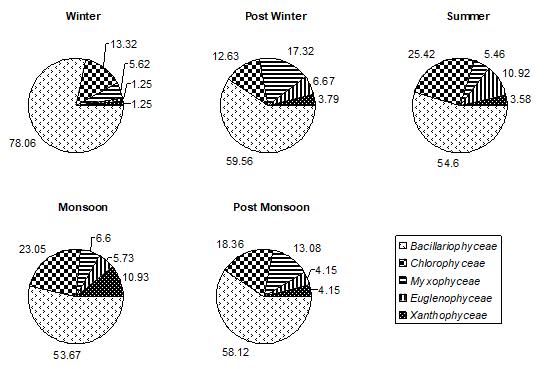
Figure 2: % COMPOSITION OF DIFFERENT GROUPS IN TOTAL PLANT PERIPHYTON ON NATURAL SUBSTRATA IN DIFFERENT SEASONS IN DIGGI POND
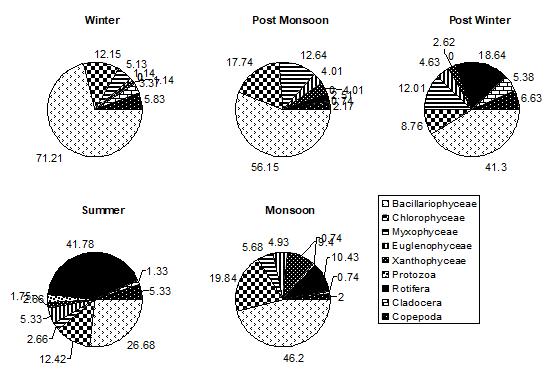
ISSN 2348-313X (Print)
International Journal of Life Sciences Research ISSN 2348-3148 (online) Vol. 10, Issue 2, pp: (21-32), Month: April - June 2022, Available at: www.researchpublish.com
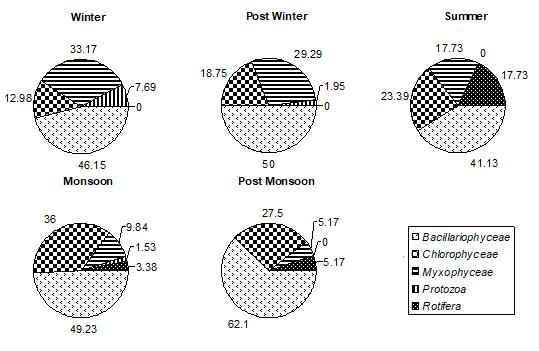
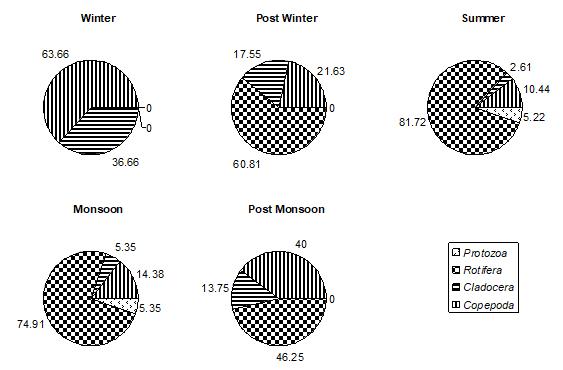
ISSN 2348-313X (Print)
International Journal of Life Sciences Research ISSN 2348-3148 (online) Vol. 10, Issue 2, pp: (21-32), Month: April - June 2022, Available at: www.researchpublish.com
Figure 5: % COMPOSITION OF DIFFERENT GROUPS IN TOTAL PERIPHYTON ON STONE BLOCK SUBSTRATUM IN DIFFERENT SEASONS IN DIGG POND
Figure 6: % COMPOSITION OF DIFFERENT GROUPS IN TOTAL PERIPHYTON ON GLASS SUBSTRATUM IN DIFFERENT SEASONS IN DIGG POND
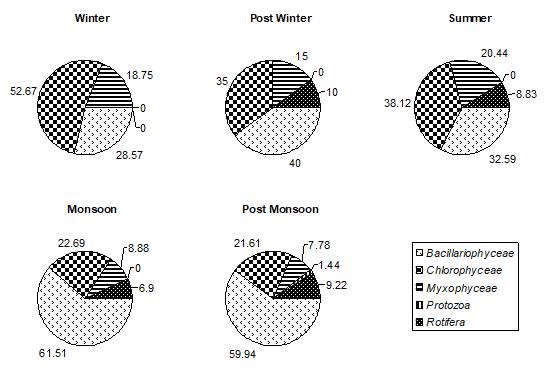
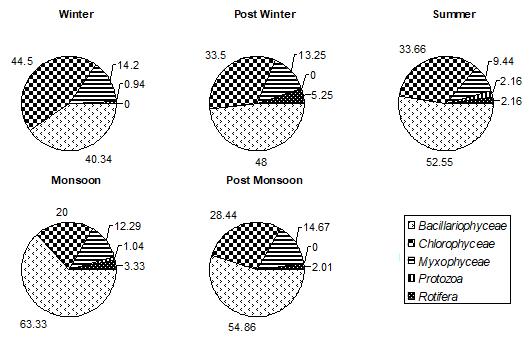
Present findings conclude that seasonal variation in physico-chemical factors directly influenced the density, species richness and diversity of periphyton in this studied fresh waterbody besides providing the essential information regarding the species composition, abundance and distribution, such studies will help in finding the indicators and their association in a community as a whole.
ISSN 2348-313X (Print)
International Journal of Life Sciences Research ISSN 2348-3148 (online) Vol. 10, Issue 2, pp: (21-32), Month: April - June 2022, Available at: www.researchpublish.com
Lastly, it can be concluded that periphyton communities are important structural and productive components of freshwater ecosystems. Although the research on periphyton has been intensified over the past decades, there is still an essential need for more information within several areas.
The Authors are grateful to the Chairman, Department of Zoology, Aligarh Muslim University, Aligarh, India for providing necessary laboratory facilities.
[1] APHA (1998).Standard- Methods for Examination of Water and Waste water.18thed. American Public Health Association. AWWA, WPCF.Washington.D.C.20005pp.
[2] Azim, M.E., M.A. Wahab, A.A. van Dam, M.C.M. Beveridge, A. Milstein and M.C.J. Verdegem, 2001. Optimization of fertilization rate for maximizing periphyton production on artificial substrates and the implications for periphyton-based aquaculture. Aquacult. Res., 32: 749-760.
[3] Bender, J., R. Lee, M. Sheppard, K. Brinkley, P. Phillips, Y. Yeboah and R.C. Wah, 2004. A waste effluent treatment system based on microbial mats for black sea bass Centropristis striata recycled-water mariculture. Aquac. Eng., 31: 73-82.
[4] Besch, W.K.M.Recard and R.Cartin.1972. Benthic diatoms as indicator of mining pollution in the north-west Miramichi River system. New Brunswick, Canada-Int.reveu ges.Hydrobiol. 57:39-74
[5] Burkholder J.M. & Wetzel R.G. (1989) Epiphytic microalgae on natural substrata in a hard water lake: Seasonal dynamics of community structure, biomass and ATP content. Archiv fur Hydrobiologie, Suppl., 83, 1-56.
[6] Carpenter S.R. & Kitchell J.F. (1987) The temporal scale of variance in limnetic primary production. The American Naturalist, 129, 417-433.
[7] Cattaneo A. (1987) Periphyton in lakes of different trophy. Canadian Journal of Fisheries and Aquatic Sciences, 44, 296-303.
[8] Cattaneo, A., M. de Seve, G. Morabito, R. Mosello and G. Tartari, 2012. Periphyton changes over 20 years of chemical recovery of Lake Orta, Italy: Differential response to perturbation of littoral and pelagic communities. J. Limnol., 70: 177-185.
[9] Cole, G.A. (1983). Textbook of Limnology (3rd Ed.). The C.V. Mosby Company, London, 401 p.
[10] Dodds, W.K., 2003. The role of periphyton in phosphorus retention in shallow freshwater aquatic systems. J. Phycol., 39: 840-849.
[11] Feminella J.W. & Hawkins C.P. (1995) Interactions between stream herbivores and periphyton: a quantative analysis of past experiments. Journal of the North American Benthological Society, 14, 465-509.
[12] Gons H.J. (1982) Structural and functional characteristics of epiphyton and epipelon in relation to their distribution in Lake Vechten.Hydrobiologia, 95: 79-114.
[13] Gustina G. W. &Hoffman J.P. (2000) Periphyton dynamics in a subalpine mountain stream during winter. Artic, antartic and Alpine Research, 32: 127-134.
[14] Jha, B.C.1979. Qualitative composition and seasonal abundance of periphyton in Getalsud Reservoir. In: Proc. Summer Institute on Capture and Culture Fisheries of Man-made Lakes in India, 7 July- 6 August, 1979, CIFRI, Barrackpore (W.B), India.
[15] Jones J.I., Moss B. & Young J.O. (1997) Interactions between periphyton, nonmolluscan invertebrates, and fish in standing freshwaters. In: The structuring role of submerged macrophytes in lakes (Eds E. Jeppesen, M. Sondergaard, &K.Christoffersen), pp.69-90. Springer-Verlag, Inc., New York.
ISSN 2348-313X (Print) International Journal of Life Sciences Research ISSN 2348-3148 (online) Vol. 10, Issue 2, pp: (21-32), Month: April - June 2022, Available at: www.researchpublish.com
[16] Jyrkänkallio-Mikkola, J., Siljander, M., Heikinheimo, V., Pellikka, P., & Soininen, J. (2018). Tropical stream diatom communities – The importance of headwater streams for regional 43 diversity. Ecological Indicators, 95(July), 183–193. https://doi.org/10.1016/j.ecolind.2018.07.030
[17] King L., Jones R.I. & Barker P. (2002) Seasonal variation in the epilithic algal communities from for lakes of different trophic state. Archiv fur Hydrobiologie, 154, 177-198.
[18] Krishna Rao, D.S.1990.Periphyton production in peninsular tank. Environment and Ecology, 8 (1): 184-188.
[19] Kumar, P., R. Mishra and D.K. Singh, 2013. Species composition of periphyton community in ponds of chapra district, Bihar, India. Int. J. Zool. Res., 3: 49-53.
[20] Laal, A.K, Sarkar, S.K. Sarkar and K.L. Shah 1982. Species diversity of perphyton as an index of pollution of River Ganga. J.Inland Fish.Soc.India, 14 (1): 44-51
[21] Liboriussen L. & Jeppesen E. (2003). Temporal dynamics in epipelic, pelagic epiphytic algal production in a clear and a turbid shallow lake. Freshwater biology, 48.
[22] Lowe R.L. (1996) Periphyton patterns in lakes. In: Algal Ecology: Freshwater Benthic Ecosystems (Eds R.J. Stevenson, M.L. Bothwell & R.L. Lowe), pp. 57-76. Academic Press, Inc
[23] Misra, J.N. and C.S. Singh (1968) A preliminary study on periphyton growth in a temporary pond.Proc. Symp. Recent Advances in Tropical Ecology, 1: 311-315.
[24] Meulemans J.T. (1988) Seasonal changes in biomass and production of periphyton growing upon reed in Lake Maarsseveen I. Archiv fur Hydrobiologie, 112: 21-42.
[25] Peterson C.G. & Stevenson R.J. (1992) Resistance and resilience of lotic algal communities-importance of disturbance typing and current. Ecology, 73, 1445-1461.
[26] Piggott, J. J., Townsend, C. R., & Matthaei, C. D. (2015). Climate warming and agricultural stressors interact to determine stream macroinvertebrate community dynamics. Global Change Biology, 21(5), 1887–1906. https://doi.org/10.1111/gcb.12861
[27] Pillsbury, R., Stevenson, R. J., Munn, M. D., & Waite, I. (2019). Relationships between diatom metrics based on species nutrient traits and agricultural land use. Environmental Monitoring and Assessment, 191(4), 228. https://doi.org/10.1007/s10661-019-7357-8
[28] Rashid, H. and A.K. Pandit, 2005. Periphytic algal community in relation to the physic-chemical features of seven water bodies of Ladakh region, Jammu and Kashmir. J. Res. Dev., 6: 71-80.
[29] Singh D.N., Sukumaran P.K. and A.K Das (2003) Periphyton production in Man-Made Lake. Indian J.Fish., 50(1): 41-55pp.
[30] Sukumaran, P.K., and M. Karthikeyan (1999) Seasonal abundance and species diversity of periphyton in Markonahalli Reservoir, Karnataka. J.Inland Fish.Soc.India, 31 (2): 93-98.
[31] Theroux, F.R., Eldridge, E.F. and Mallmann, W.F. (1943)-Laboratory Manual for Chemical and Bacterial Analysis of water and sewage. McGraw Hill Book Co.Inc., New York, 267pp
[32] Trivedy, R.K. and Goel, P.K. (1984) Chemical and Biological Methods for water Pollution studies. Environmental publication, Karad, India. pp. 215.
[33] Welch, P.S. (1952)-Limnology. McGraw Hill, Book Co.Inc., New York, 538pp.
[34] Welsh, H. H., & Ollivier, L. M. (1998). Stream Amphibians as Indicators of Ecosystem Stress : A Case Study from California ’ s Redwoods. Ecological Applications, 8(4), 1118–1132.
[35] Wetzel R.G. (1983) Opening remarks. In: Periphyton of freshwater Ecosystems (Ed. R.G. Wetzel), Dr W. Junk Publishers, The Hague